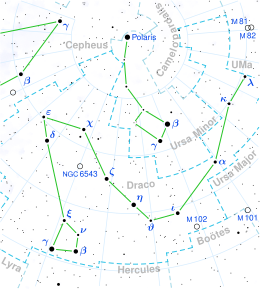Star in the constellation Draco
Lambda Draconis (λ Draconis , abbreviated Lam Dra , λ Dra ), also named Giausar ( JAW -zar[ 11] [ 12] [ 13] [ 14] star in the northern circumpolar constellation of Draco . It is visible to the naked eye with an apparent visual magnitude of +3.85.[ 2] parallax shift of 9.79 mas as seen from the Earth,[ 1] light years from the Sun .
A light curve for Lambda Draconis, potted from MASCARA data[ 15] [ 16] This is an evolved red giant star on the asymptotic giant branch [ 3] stellar classification of M0III-IIIa Ca1.[ 4] slow irregular variable with a periodicity of roughly 1,100 days.[ 5] mass of the Sun and a measured radius of 70 times the radius of the Sun . It is radiating 884 times the solar luminosity from its photosphere at an effective temperature of 3,761 K.[ 8]
Nomenclature
λ Draconis (Latinised to Lambda Draconis ) is the star's Bayer designation .
It bore the traditional name Giausar [ 17] Gianfar, Giansar and Giauzar ) and Juza. In 2016, the International Astronomical Union organized a Working Group on Star Names (WGSN)[ 18] Giausar for this star on February 1, 2017, and it is now so included in the List of IAU-approved Star Names.[ 12]
In Chinese , 紫微右垣 Zǐ Wēi Yòu Yuán Right Wall of Purple Forbidden Enclosure asterism consisting of Lambda Draconis, Alpha Draconis , Kappa Draconis , 24 Ursae Majoris , 43 Camelopardalis , Alpha Camelopardalis and BK Camelopardalis .[ 19] Chinese name for Lambda Draconis itself is 紫微右垣三 Zǐ Wēi Yòu Yuán sān the Third Star of Right Wall of Purple Forbidden Enclosure .),[ 20] 上輔 Shǎngfǔ First Minister .[ 21] Sang Poo or Shaou Poo by R.H. Allen.[ 22]
Namesakes
USS Giansar (AK-111) was a United States Navy Crater class cargo ship named after the star.
References
^ a b c d e f van Leeuwen, F. (2007), "Validation of the new Hipparcos reduction", Astronomy and Astrophysics , 474 (2): 653– 664, arXiv :0708.1752 Bibcode :2007A&A...474..653V , doi :10.1051/0004-6361:20078357 , S2CID 18759600 . ^ a b c d Johnson, H. L.; et al. (1966), "UBVRIJKL photometry of the bright stars", Communications of the Lunar and Planetary Laboratory , 4 (99): 99, Bibcode :1966CoLPL...4...99J . ^ a b Eggen, O. J. (1992). "Asymptotic giant branch stars near the sun". The Astronomical Journal . 104 : 275. Bibcode :1992AJ....104..275E . doi :10.1086/116239 . ^ a b Keenan, Philip C.; McNeil, Raymond C. (1989), "The Perkins catalog of revised MK types for the cooler stars", Astrophysical Journal Supplement Series , 71 : 245, Bibcode :1989ApJS...71..245K , doi :10.1086/191373 , S2CID 123149047 . ^ a b Samus, N. N.; Durlevich, O. V.; et al. (2007), Combined General Catalogue of Variable Stars (GCVS4.2) , retrieved 2016-09-30 . ^ Famaey, B.; et al. (2009), "Spectroscopic binaries among Hipparcos M giants,. I. Data, orbits, and intrinsic variations", Astronomy and Astrophysics , 498 (2): 627– 640, arXiv :0901.0934 Bibcode :2009A&A...498..627F , doi :10.1051/0004-6361/200810698 , S2CID 18739721 . ^ Park, Sunkyung; et al. (2013), "Wilson-Bappu Effect: Extended to Surface Gravity", The Astronomical Journal , 146 (4): 73, arXiv :1307.0592 Bibcode :2013AJ....146...73P , doi :10.1088/0004-6256/146/4/73 , S2CID 119187733 . ^ a b Baines, Ellyn K.; et al. (2018), "Fundamental Parameters of 87 Stars from the Navy Precision Optical Interferometer", The Astronomical Journal , 155 (1), 30, arXiv :1712.08109 Bibcode :2018AJ....155...30B , doi :10.3847/1538-3881/aa9d8b S2CID 119427037 ^ Takagi, Yuhei; et al. (June 2011), "Age Determinations of Early-M Type Pre-Main Sequence Stars Using a High-Resolution Near-Infrared Spectroscopic Method", Publications of the Astronomical Society of Japan , 63 (3): 677– 684, Bibcode :2011PASJ...63..677T , doi :10.1093/pasj/63.3.677 ^ "lam Dra" . SIMBAD Centre de données astronomiques de Strasbourg . Retrieved 2017-05-28 .{{cite web }}: CS1 maint: postscript (link )^ Kunitzsch, Paul; Smart, Tim (2006). A Dictionary of Modern star Names: A Short Guide to 254 Star Names and Their Derivations (2nd rev. ed.). Cambridge, Massachusetts: Sky Pub. ISBN 978-1-931559-44-7 ^ a b "Naming Stars" . IAU.org. Retrieved 16 December 2017 .^ Eggleton, P. P.; Tokovinin, A. A. (September 2008), "A catalogue of multiplicity among bright stellar systems", Monthly Notices of the Royal Astronomical Society , 389 (2): 869– 879, arXiv :0806.2878 Bibcode :2008MNRAS.389..869E , doi :10.1111/j.1365-2966.2008.13596.x S2CID 14878976 . ^ Moore, Patrick (2013), The Observer's Year: 366 Nights of the Universe ISBN 978-1447136132 ^ Burggraaff, O.; Talens, G. J. J.; Spronck, J.; Lesage, A. L.; Stuik, R.; Otten, G. P. P. L.; Van Eylen, V.; Pollacco, D.; Snellen, I. A. G. (September 2018). "Studying bright variable stars with the Multi-site All-Sky CAmeRA (MASCARA)" (PDF) . Astronomy & Astrophysics . 617 : A32. Bibcode :2018A&A...617A..32B . doi :10.1051/0004-6361/201833142 . Retrieved 13 December 2024 . ^ "ASCC 81872" . Leiden University. Retrieved 13 December 2024 .^ Kaler, James B., "Giausar" , stars.astro.illinois.edu , retrieved 2017-05-28 . ^ "International Astronomical Union | IAU" . www.iau.org . Retrieved 2017-03-31 .^ (in Chinese) 中國星座神話 , written by 陳久金. Published by 台灣書房出版有限公司, 2005, ISBN 978-986-7332-25-7 .^ (in Chinese) 香港太空館 - 研究資源 - 亮星中英對照表 Archived 2008-10-25 at the Wayback Machine , Hong Kong Space Museum. Accessed on line November 23, 2010.^ English-Chinese Glossary of Chinese Star Regions, Asterisms and Star Name Archived 2008-09-24 at the Wayback Machine , Hong Kong Space Museum. Accessed on line November 23, 2010.^ Allen, Richard Hinckley (1963), Star Names — Their Lore and Meaning: Draco, the Dragon , retrieved 2017-05-28 .

